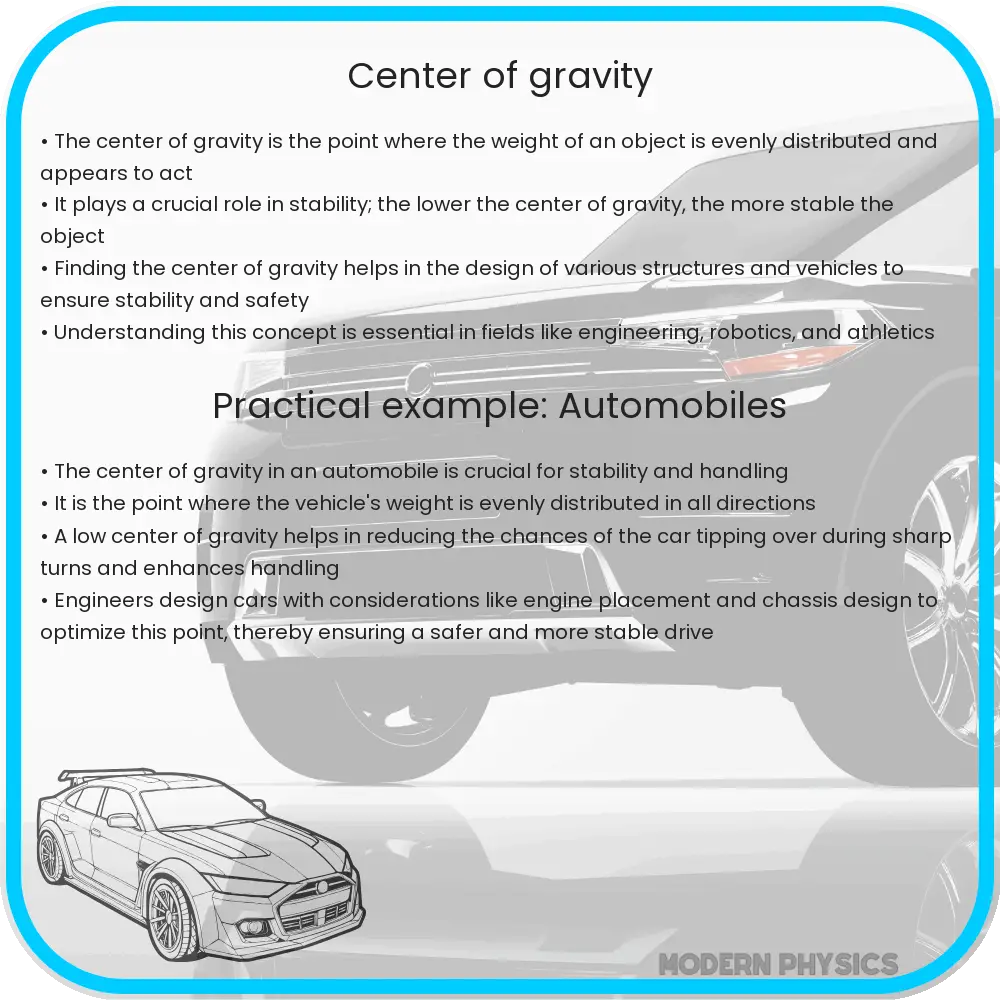Explore the fundamentals of Center of Gravity, its role in balance and stability, and its wide-ranging applications in engineering, sports, and daily life.

Understanding Center of Gravity: Basic Principles
The concept of the Center of Gravity (CoG) is pivotal in understanding the balance and stability of objects, both in motion and at rest. This fundamental principle has wide-ranging applications, from engineering and architecture to sports and daily activities. In this article, we delve into the basics of CoG, exploring its definition, characteristics, and importance in various contexts.
Defining Center of Gravity
The Center of Gravity is a theoretical point in an object where the total weight of the body is considered to be concentrated. In simple terms, it is the average location of the weight of an object. Mathematically, it can be determined by calculating the weighted average of the positions of each mass element in the object, taking into account their respective distances from a reference point.
CoG and Balance
Understanding the CoG is crucial in analyzing an object’s balance. An object is said to be in a stable equilibrium if, when disturbed, it returns to its original position. Conversely, it is in unstable equilibrium if it deviates further upon being disturbed. The stability of an object depends on the location of its CoG; the lower the CoG, the more stable the object. This is why a wide base and a low CoG contribute to the stability of structures like buildings or vehicles.
CoG in Motion
The concept of CoG is equally important in dynamics. In sports, athletes often adjust their CoG to optimize performance and maintain balance. For example, a high jumper lowers their CoG to gain the kinetic energy needed for the jump, then shifts it to clear the bar effectively. Similarly, in automotive design, the CoG affects handling characteristics, with a lower CoG generally enhancing vehicle stability and handling.
Calculating Center of Gravity
Calculating the CoG is a crucial task in many engineering fields. For simple, uniform objects, the CoG is at the geometric center. However, for complex shapes or uneven mass distributions, the calculation involves more advanced mathematical techniques. These calculations often require the integration of the object’s mass distribution over its volume, taking into account the density variations.
In summary, the Center of Gravity is a fundamental concept that plays a vital role in understanding and manipulating the balance and stability of objects. Its implications are seen in a myriad of fields, demonstrating its universal importance.
Factors Influencing CoG
Several factors can influence the position of an object’s CoG. These include the shape of the object, the distribution of mass within it, and external forces acting upon it. For instance, a person carrying a heavy backpack shifts their CoG backwards, affecting their balance and posture. Similarly, structural modifications in a building can alter its CoG, impacting its stability.
Understanding these factors is essential for effectively managing balance and stability in various practical situations.
Practical Applications of Center of Gravity
Practical applications of the Center of Gravity principle are vast and varied. In the field of aerospace engineering, for example, the CoG is crucial for the stability and control of aircraft. Ensuring that the CoG is within certain limits is vital for safe flight. In the world of construction, understanding the CoG helps in designing buildings that can withstand forces like wind and earthquakes. Similarly, in the automotive industry, the CoG impacts vehicle design, influencing factors like rollover risk and cornering ability.
Center of Gravity in Human Movement
The concept of CoG is also significant in understanding human movement and ergonomics. The human body continually adjusts its CoG in response to movements and external forces. This adjustment is crucial for activities such as walking, running, and lifting objects. Athletes, dancers, and martial artists often train to control and manipulate their CoG to enhance performance and prevent injuries.
Technological Advances in CoG Analysis
With technological advancement, tools and software have been developed to analyze and manipulate the CoG in various fields. Computer-aided design (CAD) software, for example, allows engineers to predict the CoG in complex designs and adjust it for optimal performance. Biomechanical analysis in sports uses technology to help athletes understand and improve their CoG management.
Balance, Stability, and CoG: A Unified Approach
Understanding the relationship between balance, stability, and the Center of Gravity is essential in many disciplines. A unified approach towards these concepts can lead to innovations in design, performance enhancement in sports, improved safety in vehicles, and advancements in human ergonomics.
Conclusion
In conclusion, the Center of Gravity is more than just a theoretical concept; it is a practical tool that impacts our daily lives. From the stability of buildings to the efficiency of vehicles, and from athletic performance to ergonomic design, the principles of CoG, balance, and stability are intricately linked. By continuing to explore and understand these principles, we can develop more innovative, safe, and efficient designs and techniques across various fields. The Center of Gravity, therefore, remains a fundamental concept with endless applications and significance in the real world.
